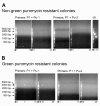Analysis of illegitimate genomic integration mediated by zinc-finger nucleases: implications for specificity of targeted gene correction
- PMID: 20459736
- PMCID: PMC2875229
- DOI: 10.1186/1471-2199-11-35
Analysis of illegitimate genomic integration mediated by zinc-finger nucleases: implications for specificity of targeted gene correction
Abstract
Background: Formation of site specific genomic double strand breaks (DSBs), induced by the expression of a pair of engineered zinc-finger nucleases (ZFNs), dramatically increases the rates of homologous recombination (HR) between a specific genomic target and a donor plasmid. However, for the safe use of ZFN induced HR in practical applications, possible adverse effects of the technology such as cytotoxicity and genotoxicity need to be well understood. In this work, off-target activity of a pair of ZFNs has been examined by measuring the ratio between HR and illegitimate genomic integration in cells that are growing exponentially, and in cells that have been arrested in the G2/M phase.
Results: A reporter cell line that contained consensus ZFN binding sites in an enhanced green fluorescent protein (EGFP) reporter gene was used to measure ratios between HR and non-homologous integration of a plasmid template. Both in human cells (HEK 293) containing the consensus ZFN binding sites and in cells lacking the ZFN binding sites, a 3.5 fold increase in the level of illegitimate integration was observed upon ZFN expression. Since the reporter gene containing the consensus ZFN target sites was found to be intact in cells where illegitimate integration had occurred, increased rates of illegitimate integration most likely resulted from the formation of off-target genomic DSBs. Additionally, in a fraction of the ZFN treated cells the co-occurrence of both specific HR and illegitimate integration was observed. As a mean to minimize unspecific effects, cell cycle manipulation of the target cells by induction of a transient G2/M cell cycle arrest was shown to stimulate the activity of HR while having little effect on the levels of illegitimate integration, thus resulting in a nearly eight fold increase in the ratio between the two processes.
Conclusions: The demonstration that ZFN expression, in addition to stimulating specific gene targeting by HR, leads to increased rates of illegitimate integration emphasizes the importance of careful characterization of ZFN treated cells. In order to reduce off-target events, reversible cell cycle arrest of the target cells in the G2/M phase is an efficient way for increasing the ratio between specific HR and illegitimate integration.
Figures





Similar articles
-
Cellular responses to targeted genomic sequence modification using single-stranded oligonucleotides and zinc-finger nucleases.DNA Repair (Amst). 2009 Mar 1;8(3):298-308. doi: 10.1016/j.dnarep.2008.11.011. Epub 2008 Dec 30. DNA Repair (Amst). 2009. PMID: 19071233
-
Custom-designed zinc finger nucleases: what is next?Cell Mol Life Sci. 2007 Nov;64(22):2933-44. doi: 10.1007/s00018-007-7206-8. Cell Mol Life Sci. 2007. PMID: 17763826 Free PMC article. Review.
-
Attenuation of zinc finger nuclease toxicity by small-molecule regulation of protein levels.PLoS Genet. 2009 Feb;5(2):e1000376. doi: 10.1371/journal.pgen.1000376. Epub 2009 Feb 13. PLoS Genet. 2009. PMID: 19214211 Free PMC article.
-
Genome editing with CompoZr custom zinc finger nucleases (ZFNs).J Vis Exp. 2012 Jun 14;(64):e3304. doi: 10.3791/3304. J Vis Exp. 2012. PMID: 22732945 Free PMC article.
-
Recent developments and clinical studies utilizing engineered zinc finger nuclease technology.Cell Mol Life Sci. 2015 Oct;72(20):3819-30. doi: 10.1007/s00018-015-1956-5. Epub 2015 Jun 19. Cell Mol Life Sci. 2015. PMID: 26089249 Free PMC article. Review.
Cited by
-
CCR5 Gene Editing of Resting CD4(+) T Cells by Transient ZFN Expression From HIV Envelope Pseudotyped Nonintegrating Lentivirus Confers HIV-1 Resistance in Humanized Mice.Mol Ther Nucleic Acids. 2014 Sep 30;3(9):e198. doi: 10.1038/mtna.2014.52. Mol Ther Nucleic Acids. 2014. PMID: 25268698 Free PMC article.
-
Zinc-finger nucleases for somatic gene therapy: the next frontier.Hum Gene Ther. 2011 Aug;22(8):925-33. doi: 10.1089/hum.2011.087. Epub 2011 Jul 22. Hum Gene Ther. 2011. PMID: 21631241 Free PMC article. Review.
-
Zinc Finger Nucleases: Tailor-made for Gene Therapy.Drugs Future. 2012 Mar 1;37(3):183-196. doi: 10.1358/dof.2012.037.03.1779022. Drugs Future. 2012. PMID: 24155503 Free PMC article.
-
Implications of targeted genomic disruption of β-catenin in BxPC-3 pancreatic adenocarcinoma cells.PLoS One. 2014 Dec 23;9(12):e115496. doi: 10.1371/journal.pone.0115496. eCollection 2014. PLoS One. 2014. PMID: 25536063 Free PMC article.
-
Long read sequencing reveals transgene concatemerization and vector sequences integration following AAV-driven electroporation of CRISPR RNP complexes in mouse zygotes.Front Genome Ed. 2025 Jun 4;7:1582097. doi: 10.3389/fgeed.2025.1582097. eCollection 2025. Front Genome Ed. 2025. PMID: 40535113 Free PMC article.
References
Publication types
MeSH terms
Substances
LinkOut - more resources
Full Text Sources
Other Literature Sources
Research Materials
Miscellaneous

